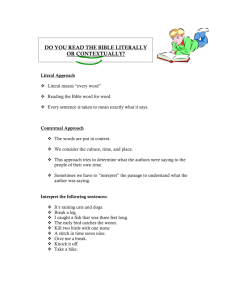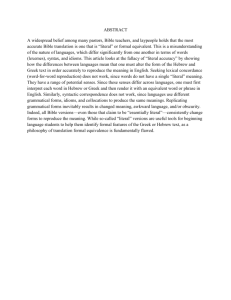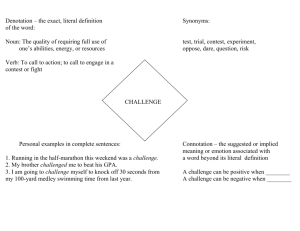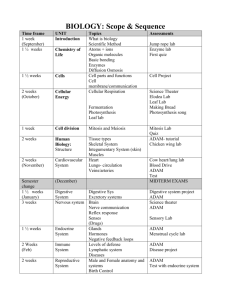WITNESSING THE AGE OF THE EARTH
advertisement
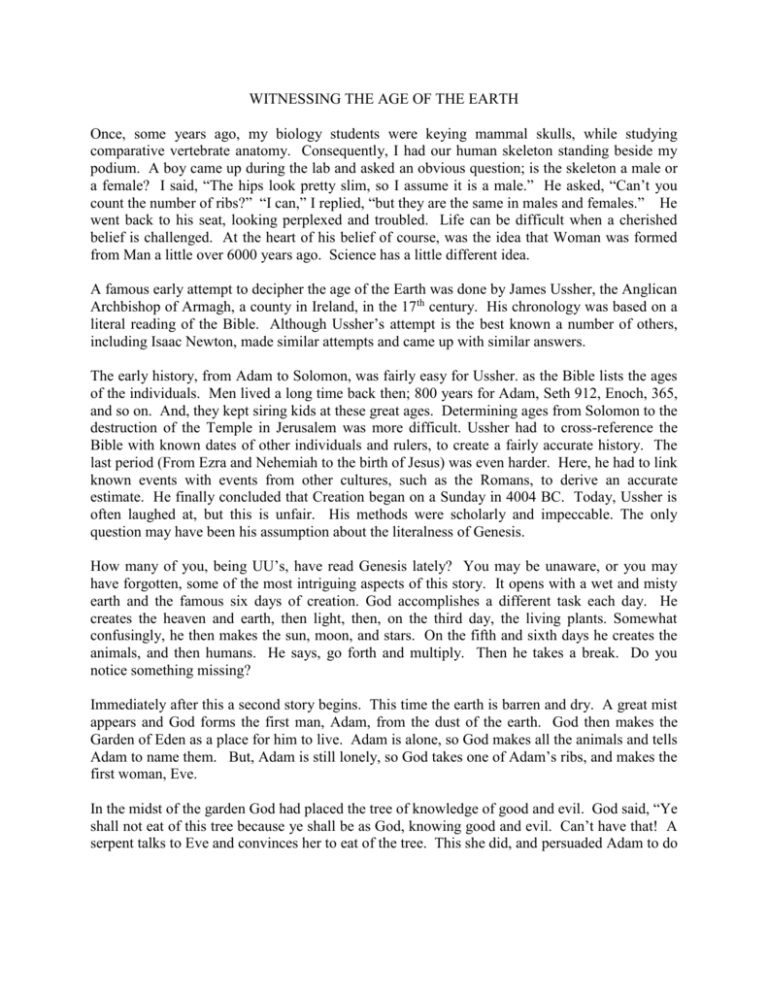
WITNESSING THE AGE OF THE EARTH Once, some years ago, my biology students were keying mammal skulls, while studying comparative vertebrate anatomy. Consequently, I had our human skeleton standing beside my podium. A boy came up during the lab and asked an obvious question; is the skeleton a male or a female? I said, “The hips look pretty slim, so I assume it is a male.” He asked, “Can’t you count the number of ribs?” “I can,” I replied, “but they are the same in males and females.” He went back to his seat, looking perplexed and troubled. Life can be difficult when a cherished belief is challenged. At the heart of his belief of course, was the idea that Woman was formed from Man a little over 6000 years ago. Science has a little different idea. A famous early attempt to decipher the age of the Earth was done by James Ussher, the Anglican Archbishop of Armagh, a county in Ireland, in the 17th century. His chronology was based on a literal reading of the Bible. Although Ussher’s attempt is the best known a number of others, including Isaac Newton, made similar attempts and came up with similar answers. The early history, from Adam to Solomon, was fairly easy for Ussher. as the Bible lists the ages of the individuals. Men lived a long time back then; 800 years for Adam, Seth 912, Enoch, 365, and so on. And, they kept siring kids at these great ages. Determining ages from Solomon to the destruction of the Temple in Jerusalem was more difficult. Ussher had to cross-reference the Bible with known dates of other individuals and rulers, to create a fairly accurate history. The last period (From Ezra and Nehemiah to the birth of Jesus) was even harder. Here, he had to link known events with events from other cultures, such as the Romans, to derive an accurate estimate. He finally concluded that Creation began on a Sunday in 4004 BC. Today, Ussher is often laughed at, but this is unfair. His methods were scholarly and impeccable. The only question may have been his assumption about the literalness of Genesis. How many of you, being UU’s, have read Genesis lately? You may be unaware, or you may have forgotten, some of the most intriguing aspects of this story. It opens with a wet and misty earth and the famous six days of creation. God accomplishes a different task each day. He creates the heaven and earth, then light, then, on the third day, the living plants. Somewhat confusingly, he then makes the sun, moon, and stars. On the fifth and sixth days he creates the animals, and then humans. He says, go forth and multiply. Then he takes a break. Do you notice something missing? Immediately after this a second story begins. This time the earth is barren and dry. A great mist appears and God forms the first man, Adam, from the dust of the earth. God then makes the Garden of Eden as a place for him to live. Adam is alone, so God makes all the animals and tells Adam to name them. But, Adam is still lonely, so God takes one of Adam’s ribs, and makes the first woman, Eve. In the midst of the garden God had placed the tree of knowledge of good and evil. God said, “Ye shall not eat of this tree because ye shall be as God, knowing good and evil. Can’t have that! A serpent talks to Eve and convinces her to eat of the tree. This she did, and persuaded Adam to do the same. After that both knew they were naked, and God was angry. He banished them from the garden. He told the woman that she would suffer great pain at childbirth, and that from this point on she must be subservient to her husband. They bore Cain and Abel. Cain slew Abel in a fit of jealousy and was banished. He married. Who did he marry? They had a son, Enoch. These are two very different stories that would seem to pose a bit of a problem for Biblical literalists. We don’t know for sure how these stories came to be. There are different explanations. I think the most plausible is that a remarkable writer, probably a Jewish priest, tried to construct a history of his people around 560 B.C. The writer may have felt his story would not be complete, without an explanation of how things came to be. The six days story may have been a common tale at that time. It’s not clear why he included the second; but in the original Hebrew version, he used an older name for the deity than in the first story. Thus, the second story is certainly older than the first, and likely may have been told around campfires as much as 3000 years ago. Because of these contradictions, people have long debated whether Genesis is literally true. Many early Jewish writers considered the spiritual and allegorical interpretations of Genesis to be more important than the literal, and felt this was the intent of the author. Philo, a prominent first century Jewish writer, thought the literal interpretation was for those unable to see deeper underlying meanings. To a large extent, the early Christian Faith also read creation history as an allegory. Augustine (354-430) thought the Biblical text should not be interpreted as properly literal, but rather as metaphorical, especially if it contradicted with what we know from our God-given reason. He believed the days had nothing to do with actual time. In the 13th century Thomas Aquinas believed strongly in the truth of Scripture, but warned to be ready to abandon it, if it proved with certainty to be false, lest Scripture be exposed to ridicule. Not all agreed, and by 1517 Martin Luther was advocating strongly for the six literal days of creation. I am not comfortable judging other people’s faith. But, I am by nature a skeptic, and I honestly do not understand how people can argue for the inerrancy of the Bible, with so many contradictions, just in the first few pages. To me, this is blind faith. If the Bible is the literal word of God, why didn’t God tell us the world spun on its axis and revolved around the sun? He must have known. It would have saved Copernicus and Galileo a lot of trouble. In the Apology by Plato, Socrates famously says, “The unexamined life is not worth living.” Shouldn’t this also extend to our faith? If we don’t examine our belief structures, we limit our ability to grow and become more knowledgeable. We close our minds to new ideas. This, of course, is not an unusual thought for UU’s, as our church has always included skepticism. In the 1500’s our church’s beginnings revolved around the rejection of the Trinity and Hell. Those early Unitarians were a bunch of heretics! As I prepared this talk I became increasingly curious about the basis for literal faith. I searched through many Christian websites trying to better understand it. I will come back to my conclusions in a little bit. First though, let’s look at how science has measured the age of the earth. The scientific method depends upon the mysterious nature of radioactive decay. Ernest Rutherford, along with others, first began to understand the structure of the atom and radioactivity in the early 1900’s. He predicted we would eventually be able to use this knowledge to determine the age of the earth. It wasn’t until the 1950’s though, that our knowledge of atomic structure became good enough to measure geologic time. These measurements depend upon the fact that some elements, like uranium, emit subatomic particles (primarily alpha particles) from their nucleus in a very regular fashion, completely independent of temperature and pressure. When alpha particles are emitted, Uranium becomes a different element. It goes through fourteen steps, eventually becoming stable lead. If you have a chunk of U-238 and keep it long enough, it will become lead. The only problem is that U-238 has a halflife of 4.5 billion years, so you are going to have to wait a while to get your lead. In order to age date a mineral; you take a core sample from deep in a rock that was once liquid magma, like lava or granite. You must make sure there has been no metamorphosis or leeching from water. As long as the uranium was in molten magma, the lead resulting from radioactive decay was mixed and lost. When the magma hardens, the lead is trapped, along with the parent uranium. In the lab, a small sample is vaporized, and the gases are pulled into a mass spectrometer. The spectrometer can detect how much lead came from radioactive decay. It can do this because this lead has three more neutrons and a slightly different mass than regular lead. The spectrometer will also tell you, how much parent uranium you have left. With this information, knowing the half-life, the age of the rock when it hardened can be determined. But how can you check your assumptions? Other radioactive elements can also be used, including Uranium-235, Potassium-40, Thorium-208, Rubidium-87, and others. All of these have different half-lives, ranging from millions to billions of years. Measurements using these different minerals, when taken from similar igneous rocks, give us similar ages. This is a reliable check. In the last 60 years tens of thousands of radiometric measurements have been made from rocks from all over the world, yielding a remarkably consistent record that correlates well with the fossil record. The oldest rocks found so far were found near Hudson’s Bay in Canada. They were dated at 4.28 billion years, giving us an estimate of around 4.5 billion years for the age of the earth. It’s pretty illogical to think that all these techniques could be wrong enough to account for the difference between 6000 years and 4.5 billion years. Fossils are not dated directly, since they are usually in sedimentary rocks. Lucy, for example, is about 3.2 million years old. They were able to determine her age by dating volcanic tuffs, located in layers above and below her, and then extrapolating her approximate age. Radiocarbon dating, or carbon-14, is not used for these measurements, as it is only accurate to about 50,000 years. Radiometric dating is not the only evidence for an old earth. Using spectroscopy, astronomers found young stars are mostly hydrogen. Our sun is a middle-aged star. Although I am simplifying this greatly, the great mass of the sun pulls hydrogen nuclei into each other, creating helium. In this process some mass is turned into energy, which we experience as sunlight. This is nuclear fusion; it is the same thing that happens in a hydrogen bomb. Our sun is currently 28% helium with the rest being primarily hydrogen. It has taken about 4.5 billion years for the sun to use up this much hydrogen. Independent, correlating evidence of this type is the best way to confirm our theories about the age of the earth. Despite this hard evidence, 40% or more of the U.S. population rejects these findings, and claim that God created man, pretty much in his present form, within the last 10,000 years. They reject modern geology. They believe that death and suffering originated with Adam’s fall (The original sin), and did not exist before that. This had to be, if Christ died for our sins. This had to be, to fulfill the prophecy that there will be a future restoration eliminating suffering. They believe, the message of the Gospel falls apart, if the earth is millions of year old and there has always been suffering. Ken Ham, who built the Creation Museum in Petersburg, Ky., exemplifies this thinking. He believes that biblical truth trumps all other knowledge. For him, “God’s Word,” is timeless and eternal, in contrast to the fleeting notions of “human reason.” Thus, he knows that the earth is less than 10,000 years old, humans and dinosaurs lived together, and women are subordinate to men. In contrast, many Christians believe the Bible is not the literal word of God, but rather the word of men interpreting their God. Ironically, the first mention of “Original Sin” is not in Genesis, but in the fifth chapter of Romans, written by Paul after Christ’s time. In contrast to religion, scientific theories are based on observable, testable, evidence. Theories are changed as new evidence is discovered, making them more accurate over time. But science is also based on faith. This is the faith that the universe is controlled by a consistent, knowable set of laws. Religious beliefs are not as easily changed as scientific theories, and often claim, as is the case with Mr. Ham, an exact accuracy; something scientists know they will never achieve. I’ll go back to science one more time. In 1849, Armand Fizeau, sent a beam of light through a rotating wheel, with a number of teeth around the outside. A mirror on the other side reflected the beam back each time a gap appeared in the light’s path. Fizeau rotated the wheel faster and faster until a tooth blocked the return beam. Knowing the speed of the wheel and the distance to the mirror, he calculated the speed of light. His measurements were pretty good considering his apparatus. Since then the speed of light has been measured, with great accuracy, at a little over 186,000 miles per second. Last month, an exploding star, a supernova, was seen near the arm of the big dipper. It was pretty close, 21 million light years away. A light year is a measure of the distance light will travel in a year. That means the star blew up 21 million years ago, not last month, because it took that long for the light to reach the earth. That couldn’t be if the universe is young. There is, incidentally, enough energy in a supernova explosion to form all the elements, including the heavy ones like uranium. Our solar system and earth formed from a nebula created by such an exposion. The late Carl Sagan enjoyed talking about how the elements that formed our world and bodies came from stardust. I’ve always liked that idea. One of the most spectacular close stars is the red giant, Betelegeuse. It is an old star. It will eventually explode in a supernova. Actually, it may have already done so, and we may never know. That’s because it is 430 light years away. If it blew up 100 years ago, the light won’t reach earth for another 330 years. Things like this we can’t ever know are sometimes called the “absolute elsewhere.” Thousands of years ago people tried to explain their origins. We are still doing this. But, we have learned a lot since then. Shouldn’t our explanations and our faith reflect this? I am saddened by the anti-science bias in this country. Science gives us valuable and exciting perspectives, but it can’t deal with everything. Science can’t tell us how to live a good life. It can’t give us clues about the presence or absence of a deity. I find comfort in the fact that Unitarian Universalism asks us to “pursue a free and responsible search for truth and meaning”. This principle draws from “humanist teachings which encourage us to heed the guidance of reason and the results of science, and warns us against idolatries of the mind and spirit.” For me, this is so much more positive than obsessing over supposed sins derived from a long ago, probably imaginary, transgression by Adam.
